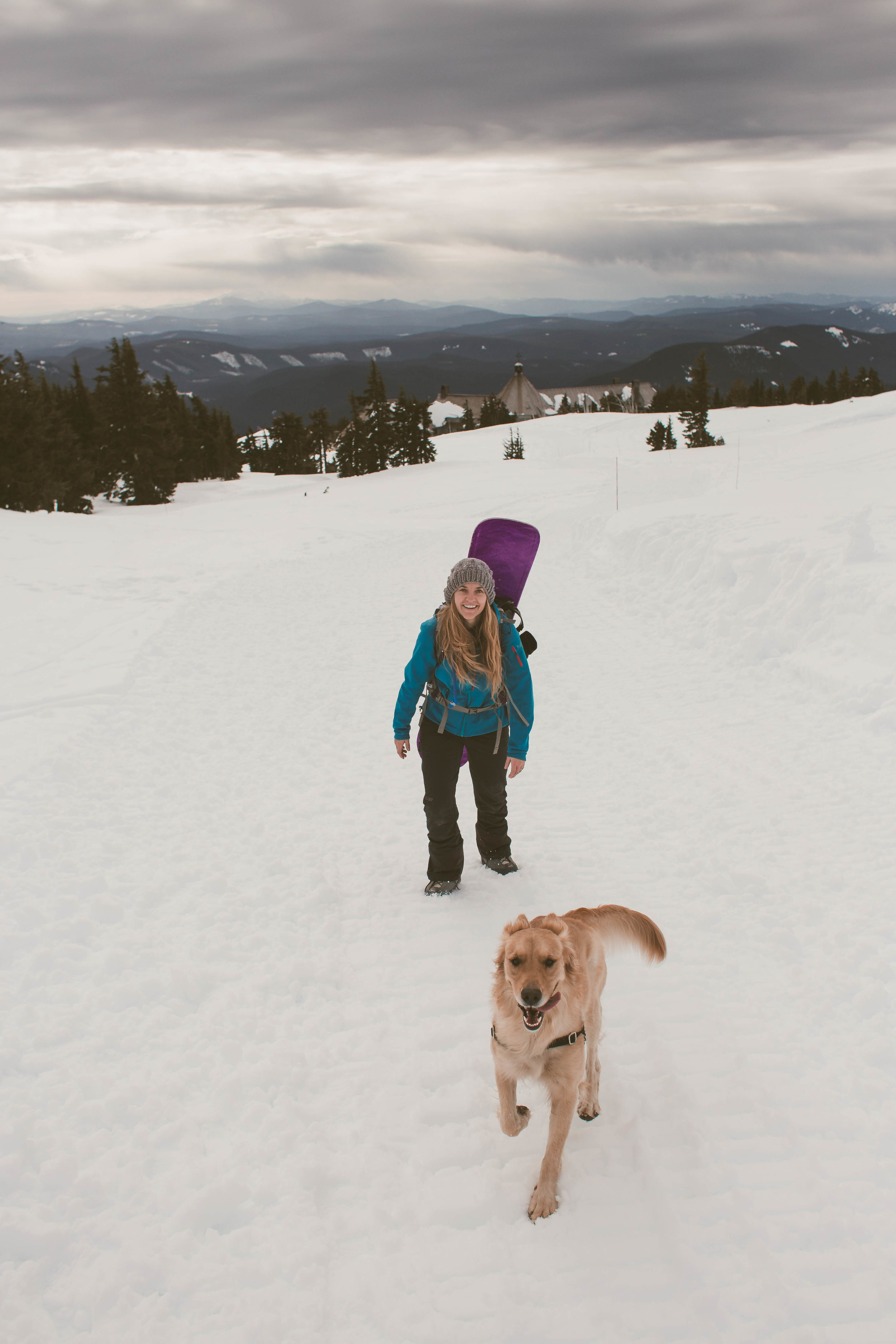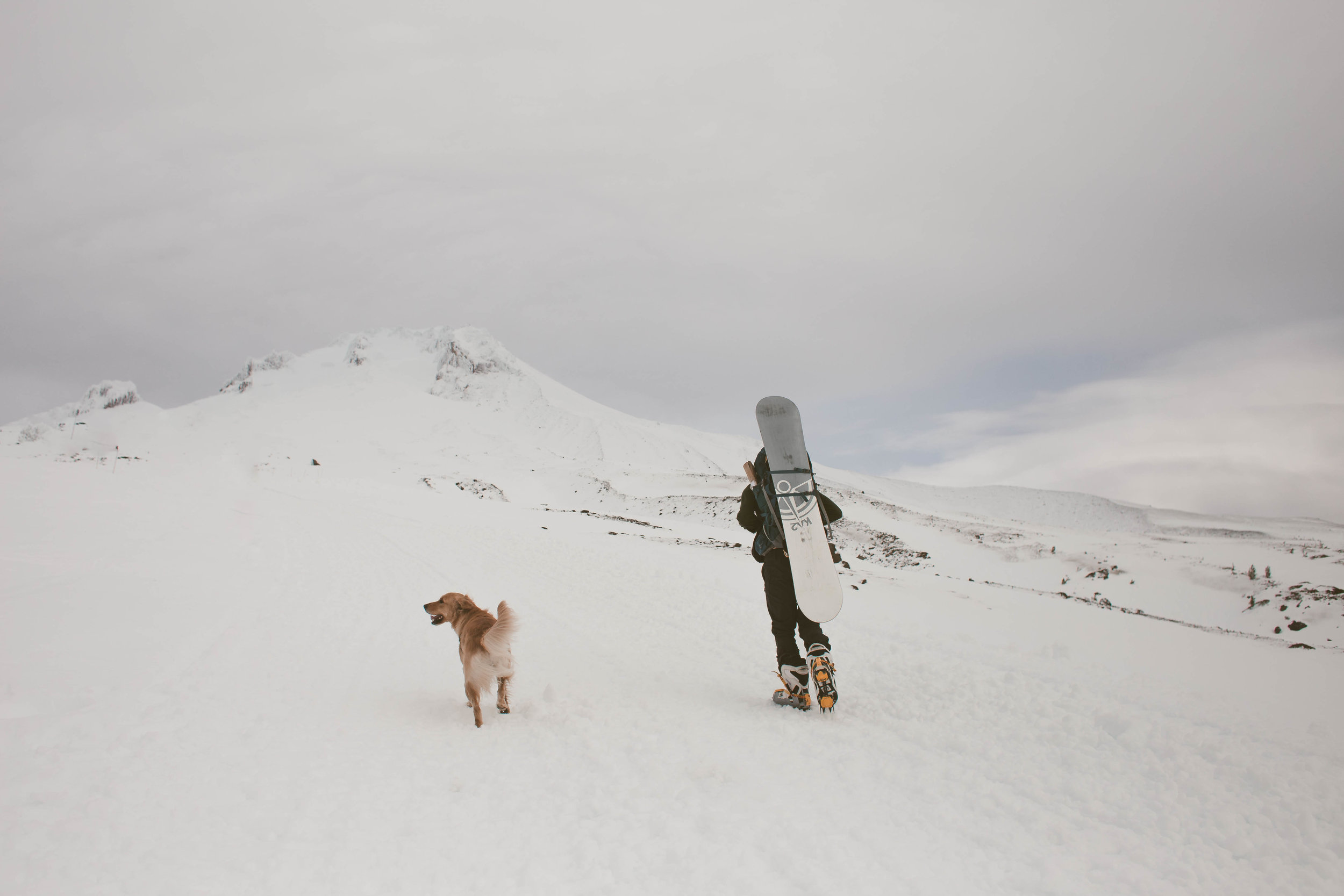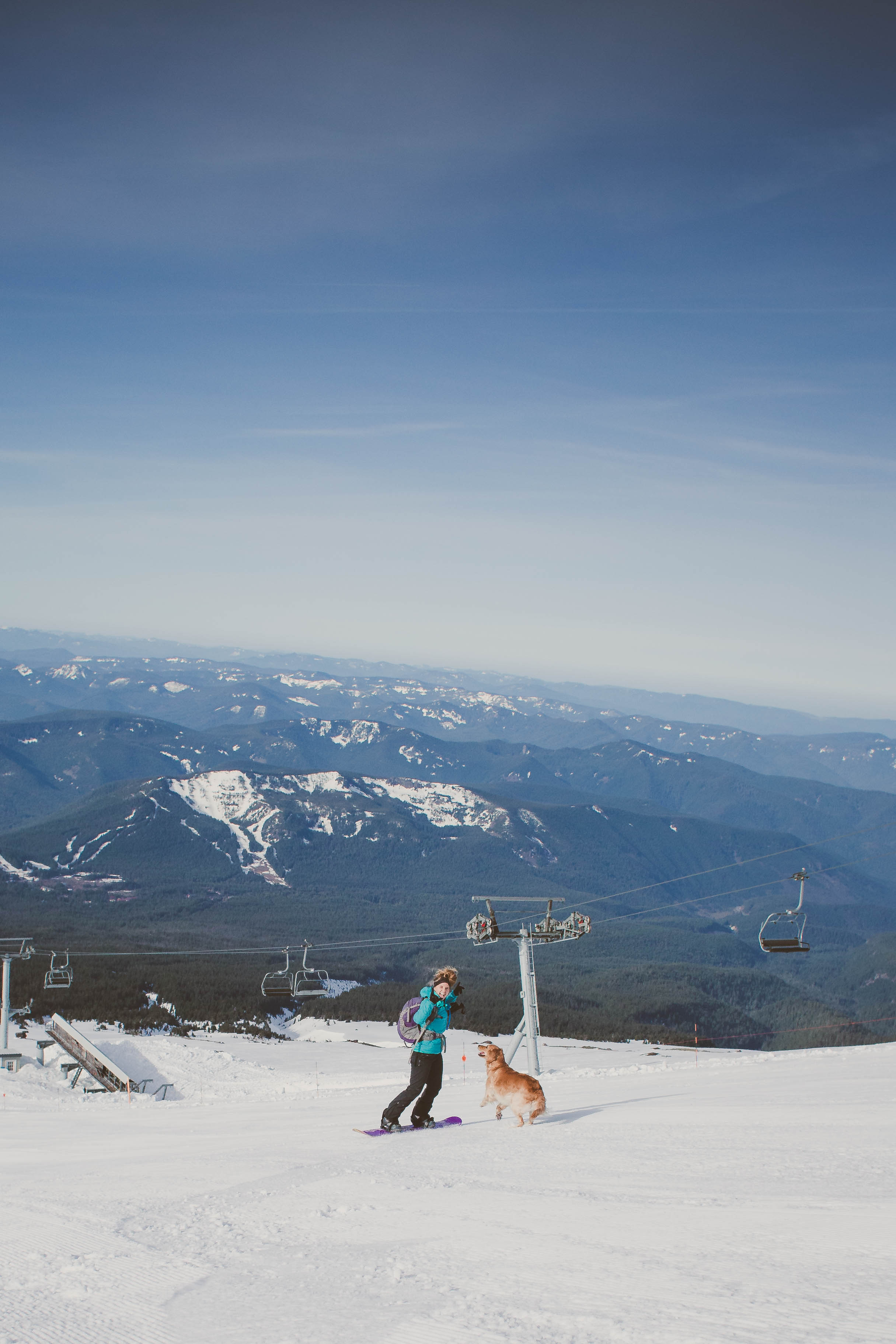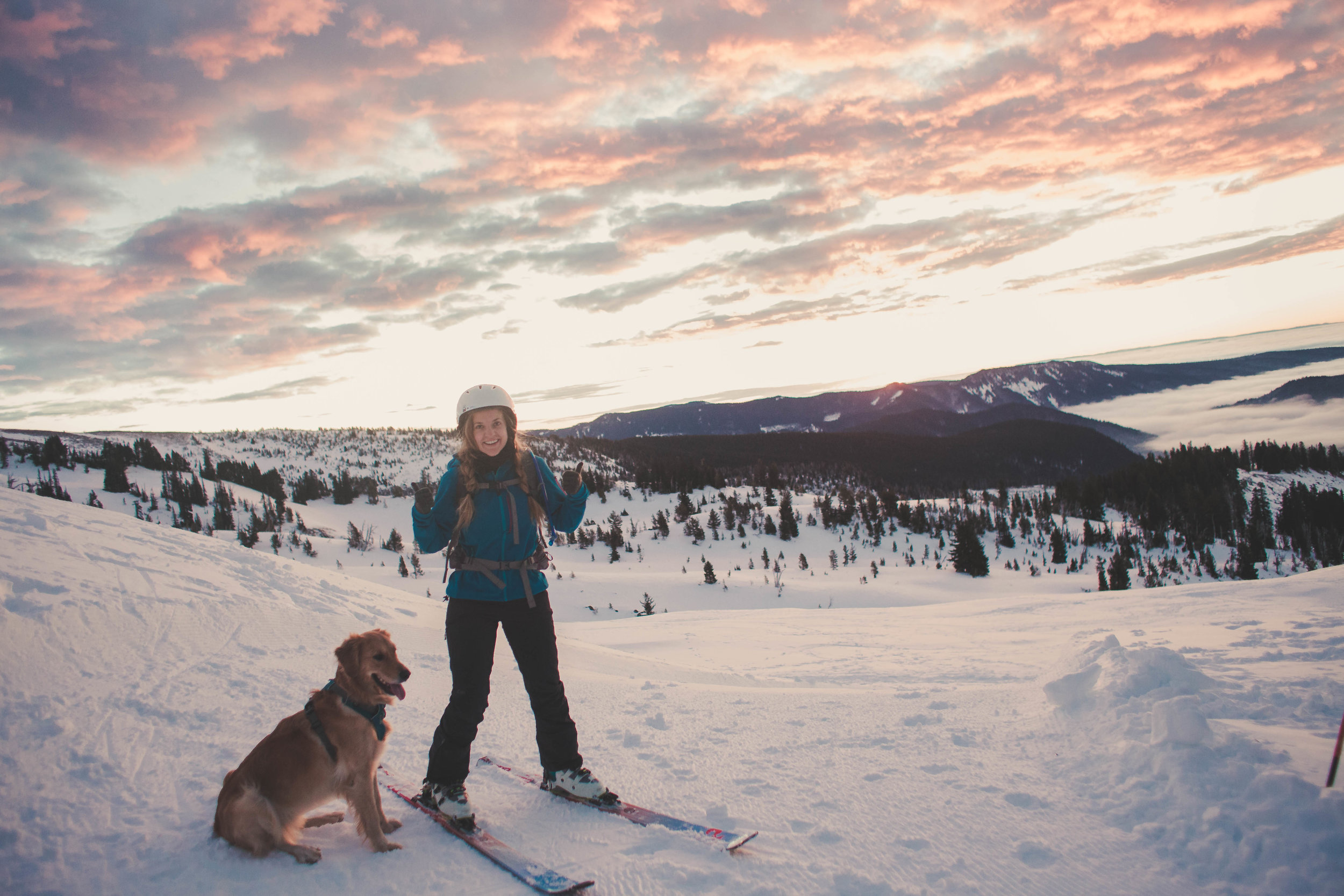One of the ways Rich and I are easily able to last minute decide to get out the door for a cold, winter, week-night camp night, or early morning pre-work dawn patrol on Hood, is we essentially wear the same layers every time. Maybe adding or subtracting a few depending on how cold it is… but the staples stay the same!
I think this has alleviated a lot of the anxiety and time trying to figure out what to wear, how to stay warm, and how to not constantly be taking on or off layers through out your activity. Working as a Sales Manager in the Outdoor retail world taught me a LOT about layering. I sat through many layering clinics by Arcteryx, Mountain Hardwear, Patagonia, The NorthFace… who knew there was so much to learn about how to layer well! Growing up in a cold climate (the snowiest place on earth!) Nagano, Japan, also taught me to get outside no matter the weather and just have fun! However, I’ll admit that getting out on the ski slopes without proper layers is miserable… or being on a backpacking trip and realizing you didn’t bring enough layers for the freezing nights and morning is also… miserable!
So, my goal with this post is to provide some general principles or “rules” on how to layer well and also give you my non-biased, non-sponsored, guide to the layering pieces I choose for adventures!
How to Layer Well
I can’t tell you how many times I’ve talked to customers, or friends, who bought an outer-shell but complained it didn’t keep them warm… or, living in the PNW, how many times I see individuals wearing a nice down jacket in the pouring rain. Yikes! I don’t blame them. To be honest, if no one has ever educated you on layering it’s frustrating… sometimes you just keep buying jackets trying to figure out how to stay warm or what to wear.
I’m a big fan of the philosophy, buy it once and buy it well. Most of my nice winter pieces I’ve had for years. As a matter of fact, it wasn’t until last year that I finally upgraded my snow pants that were my brothers snow pants when he was 12! That means they lasted us 15 + years! Thanks Mom and Dad for buying us good snow gear as kids!! Even if I was the youngest and got the hammie-downs most of the time. :)
Essentially, I’m going to divide this into four topics, base layers, mid-layers, outer-shells, and accessories. Eventually, I’ll try and make some good videos explaining each of these better.
Picking a good base layer
I credit staying warm to my base layers. Hands down! I own two base layers from the company Icebreaker that I’ve had for 8 years. They are still in mint condition and you can guarantee I’m almost always wearing one of the two.
Icebreaker Women’s quarter zip, weight 150 - this is my go to for any high exertion winter activity. It wicks away the sweat like nobodies business, it insulates my own body heat, PLUS a huge bonus is it NEVER retains an odor! Meaning, I can go for who knows how long without washing it. You may think I’m crazy but it’s a real part of the way these pieces are made! I’m actually such a BIG fan of Icebreaker that I did my senior business project on their company.
Icebreaker Hoodie - weight 260 - so, this is not the exact piece I own. As I said, I got it 8 years ago so maybe they don’t make what I have anymore. However, it’s very similar. A 260 weight pullover hoodie. Anytime I am even slightly nervous about being cold on an adventure I’m packing this piece. It’s technically listed as a mid-layer on Icebreaker’s website, however, I wear it next to my skin. It has all the base layer properties. I wear this for backpacking, cold nights and freezing mornings, camping, and anytime we head up the mountain it’s at least in my pack if not on. I can honestly say I’ve never been cold when wearing this piece as my base layer (along with my mid layers and shell).
Outdoor Research base layer leggings - for my legs, although a base layer is still extremely important, I find that for most of what I do (which is not extreme mountaineering or anything) I run on the hot side and am pretty active. I bought a nice, but a little more affordable, base layer for under my pants that has worked really well! The fit, odor resistance, and overall insulation isn’t anywhere near Icebreaker’s but it wicks away sweat and that was what I was looking for in a pant base layer.
Picking a good mid-layer
If you’re going to skimp a little as far as expense goes, do it on the mid-layer. I know we aren’t all millionaires and getting a whole set from base to outershell of best of the best is pretty expensive! Eventually, upgrade your mid-layer game… but if you have kids that are growing like weeds, or simply want to save some money, you can still stay warm without breaking the bank.
The reason I say this is because mid-layers are where you can layer on layer. Meaning, wearing two base layers really isn’t going to do you any good. However, wearing a cheap base layer that’s not wicking away sweat under a SUPER expensive and nice down jacket isn’t going to do you any good either.
An affordable way to mid layer might be:
Fleece quarter zip + a down vest
Or, synthetic puffy jacket
I will say, overtime, as I’ve upgraded my mid-layer game I’ve noticed a pretty dramatic difference and for those extra cold nights (hiking up Mt. Hood in the 20’s at midnight) i’m pretty thankful for my 800 fill down.
Here are my go-to mid layer pieces:
Outdoor Research down vest - they don’t make the one I have anymore (again, I’ve had it for 8 years). However, you can find a good down vest from Patagonia, The Northface, and other outdoor companies. I really like the vest because it’s an easy way to keep your core warm without overheating.
Arcteryx women’s down jacket - my husband got me this for my birthday 2 years ago and I wear it almost everyday as a lifestyle piece, and I pack it for all our adventures. It can pack down small enough to fit into my purse, it has a hoodie so my head is kept well warm, AND it’s 850 power fill down. I’ll explain the number value associated with down in a second. This is probably the warmest mid layer piece on the market in my opinion. At least, for somewhat normal activities - we aren’t talking about summiting Everest or anything. ;)
Outdoor Research women’s synthetic hoodie - this is a piece that to be honest, I probably wouldn’t have paid to add to my collection. Outdoor Research gifted it to me through a promo! I would say it is a “nice to have.” It’s great for the fall/winter or winter/spring transition months since it’s not AS warm as my down jacket but still provides insulation. I like using it for rock climbing, winter trail running, or a spring mid-layer on the mountain.
If you have a SOLID base layer system down, I honestly don’t think you need any more mid layers than a good down vest and a good down jacket. For extra cold adventures you can even double the vest under the jacket! Down is the MOST insulating material on the planet which is really what you want your mid layer to be all about. INSULATION.
Common questions about mid layers:
What does the fill number mean for down? 850 fill down? 700 fill down? To quote another great article on the subject, How to Choose the Best Down Jacket, “The number is actually a volume — the amount of cubic inches one ounce of down occupies. For example, one ounce of 800 fill-power down will occupy 800 cubic inches when compressed by a standardized weight. If you use two ounces of 800 fill on jacket A, and two ounces of 700 fill on jacket B, jacket A — with the 800 fill down — will be warmer because it has more loft.”
So, do I always have to wear an outer-shell over my mid-layer? Why can’t my down jacket also be my outer shell? The major con with a down jacket is:
It’s not totally wind proof. Meaning, try wearing a downjacket while zipping 30mph down a ski slope and the wind chill will cut you right to the bone!
It’s not totally water proof. Meaning, in the pouring rain not only will you get wet through the seams and zippers, but your down fill isn’t made to get soaked. Over time, you’ll ruin your down jacket a lot quicker without an outershell!
HOWEVER, for walking around town on a cold, crisp, day (no crazy wind and no crazy rain) down may double as the perfect outerjacket, too! Lots of great down lifestyle pieces exist like the down parkas. If you’re worried about wind or rain, just get a shell that fits over your down.
Picking a good outer shell
The bottom line is your outer shell should be windproof, waterproof, and breathable. However, most of the time, outer shells aren’t made to keep you insulated. That’s the job of your mid and base layers. I had a friend that was really upset about a Nortface jacket she purchased that didn’t keep her very warm. Well, it was a shell with a micro-fleece liner. The pro with online shopping is it’s quick and easy! However, the pro with going into a quality outdoor store and talking to a professional on gear, is that you walk out of the store with a product you know will fit your needs.
I have two shell jacket options:
Outdoor Research hardshell - to be honest, this shell doubles as a rain jacket. it’s lightweight and there’s no insulation. But, I prefer to have as minimal pieces as I can that are multi-functional. This shell isn’t technically a mountaineering jacket or a snowboarding jacket, but since I got a good system underneath going on I can get away with wearing it for any activity. From strolling in the rain around Portland, to hitting the slopes in the winter, it works! Just make sure it’s room-y enough to fit a few layers underneath.
Arcteryx softshell - another piece i’ve had for 8 + years and still in mint condition. A softshell, although it’s windproof, is not totally waterproof. Being the brand Arcteryx my softshell jacket is actually more waterproof than a lot of lower quality brands “water proof” standards. As long as it’s not a downpour, and if it’s a little chillier, I choose this jacket as my outer shell. It’s especially nice for mobility as the shell fabric is stretchier! However, if I KNOW I’m going to be sweating a lot in an activity (winter trail running) there’s no way I’ll choose to wear this jacket as my outershell. I just get too hot too quickly. I’d rather have my OR hardshell for breaking the wind without the insulation.
My go to outer shell pants:
Outdoor Research women’s Circue pants - these are the pants I finally upgraded to after wearing my brother’s snow pants since I was 11. Now, the OR pants I listed here are technically soft shell pants. They aren’t 100% water proof and if it’s REALLY (like 30mph gust of wind…) windy I can feel the wind cut through. However, I HIGHLY recommend these pants. They work for all our outdoor winter activities. The only con is for backpacking, they are heavy if I end up not wearing them. Which, makes me see the appeal for a nice light-weight pair of hardshell pants. Maybe someday I’ll invest in a pair of hardshell… but if I have to choose between hardshell and soft shell when it comes to pants, soft shell fits my activities and lifestyle much better.
Picking winter layering accessories
Things you need to keep on hand:
A good and warm beanie (unfortunately i’ve learned that sometimes the warmest beanies aren’t the cutest). Make sure it covers your ears and maybe even has a fleece liner around the headband area.
A good and warm pair of gloves or mittens. I have a gortex pair of mittens (my Dad bought them for me 20 years ago!!!) I wear for my colder winter activities, and a knit pair of outdoor research gloves I wear on a more regular basis.
Wool socks!! Don’t skimp on your socks. Get something similar to smartwool and appropriate for the activity you are doing. I have a couple pairs of midweight wool socks and 1 pair of heavier weight wool socks.
Merino wool buff - buffs work great for either covering your ears on a trail run, or warming your neck and face on a cold windy mountain hike.
And that’s the bare essential list! There’s also things like down booties which I’ve been eyeing for extremely cold camp nights… or a windproof buff… but to be honest, you can get all wrapped up in trying to get the right gear before you get out and that’s not the point! Get a few things you know you’ll need and just get outside and enjoy! Don’t worry about having a wide variety to choose from, I can mix and match with any of these pieces to do any of our activities.
Lastly, remember the pieces I have listed are simply recommendations that have worked well for me! You can take the “Rules of Layering” guide and essentially apply it to any brand of clothing. Heck, you can get your whole layering kit from Wal-Mart if you need to! Don’t let what you’re wearing, or not wearing, keep you from getting outside.
“Free-loofts-liv - the Swedish/Norwegian word directly translates as ‘free air life’ and is simply the process of spending time outdoors and enjoying nature.”






